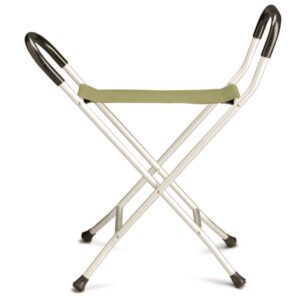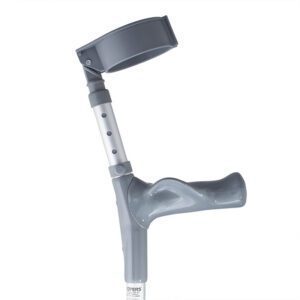These lightweight forearm crutches are available in three sizes to suit people of different height and are best suited for people seeking greater walking flexibility and for longer term use (when compared to underarm crutches).
Typically, forearm crutches require more strength in general than underarm crutches so while they promote better posture and potentially reduce strain on the wrist, they can be slightly more challenging to master.
This is why forearm crutches are often better for longer term use or for people who find underarm crutches especially uncomfortable.
These crutches feature a moulded semi-circle arm cuff that wraps around the upper arm for comfortable support.
They also have anatomically shaped, moulded handgrips to ensure that pressure is evenly distributed across the hand.
The height of both the forearm cuff and the handgrips can be independently adjusted, guaranteeing a comfortable fit.
The crutch is made from a lightweight aluminium tube and features push button height adjustment for quick adjustment.
The steel handles are strength welded to the frame making them very strong.
Suitable for people weighing up to 110 kilograms.
Three sizes are available, with the following as a rough height guide:
- Small for people 1.4 metres ; 1.6 metres in height
- Medium for people 1.6 metres ; 1.8 metres in height
- Large for people 1.8 metres ; 2 metres in height
The two main types of crutches are forearm crutches and underarm crutches each catering to different user needs.
We recommend you consult your local healthcare professional to determine which model is best for you.
You may want to consider the following factors when considering the right option:
Strength Both underarm and forearm crutches require upper body strength from the user.
You will be supporting your weight with your arm, shoulder, and chest muscles.
However, forearm crutches tend to require more strength in general.
These are great for long-term users, who can build up the muscle mass and strength they need, but for the short term underarm crutches may be easier to use.
If you have limited upper body strength, you will want to try underarm crutches.
Posture Posture is one very important factor to consider when choosing crutches.
Many first-time users of underarm crutches tend to slouch over their crutches, and this can be a hard habit to break, eventually leading to strain and muscle pain.
Forearm crutches, however, encourage good posture in their users- the taller and straighter a person stands, the easier their crutches will be to use.
If you are worried about posture, you will want to try forearm crutches.
Coordination Underarm crutches are generally easy to master, as they have one basic possible gait.
Forearm crutches can be more difficult to coordinate, and often require the consultation of a physical therapist to fully master.
However, forearm crutches allow for a greater variety of walking styles and gaits, and are more stable on rough or uneven terrain.
If you have trouble with balance and coordination, you will want to try underarm crutches.
If you require more flexibility from your crutches, you will want forearm crutches.
Comfort Forearm crutches feature a cuff under the elbow which helps reduce strain and keeps some of the pressure off the wrist while in motion, making these crutches comfortable and easy to use.
Underarm crutches, however, press against the side of the body when used, often leading to soreness and abrasions no matter how much padding they feature.
If comfort is your main concern, you will want to try a pair of forearm crutches.
| Size | Small, Medium, Large |
|---|
Related products
-
Mobility
Coopers Walking Frame – Non Folding
-
Mobility
Walking Stick Seat
-
Mobility
Quad Stick









